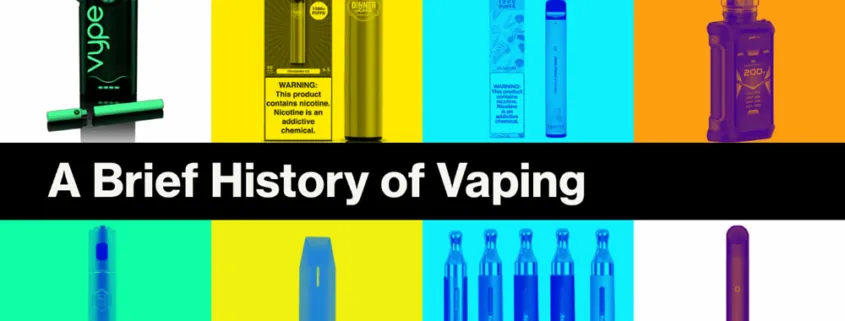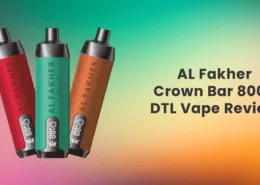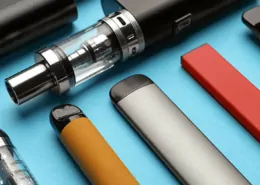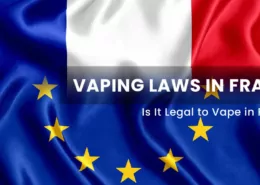A Brief History of Vaping
In fact, although vaping devices have been on the market since only about 2007, almost half of all U.S. high school students have already tried vaping at some point in their lives and about a third report vaping regularly. And about 5 percent of adults currently vape. Those are astonishing figures given that vaping barely existed just over a decade ago.
The early vaping innovators were motivated to find safer alternatives to smoking tobacco. They claimed that they wanted to decrease the risks of regular cigarettes, which represent the leading cause of preventable deaths in the United States. And many smokers do, indeed, look to vaping as a potential way to help them quit smoking.
So, in this article, we give a brief overview of most of the major types of e-cigarettes (vaping devices) that you’re likely to encounter. We also discuss the various liquids that are available for vaping. Both the devices and what goes into them are evolving rapidly.
The first patent for an electronic cigarette was granted to Joseph Robinson in 1930. It’s unknown whether the device was ever actually constructed, but it was not marketed. In the 1960s, Herbert Gilbert created an e-cigarette device that was also never commercialized.
The first commercially successful e-cigarette was produced by a Chinese pharmacist and inventor named Hon Lik, a former heavy smoker whose father died of lung cancer. Since its introduction to the marketplace almost 20 years ago, vaping has become remarkably popular. The device developed by Hon Lik was called Ruyan, which means, “light smoke.” Vaping nicotine was first introduced in the United States in 2007. Extremely rapid growth in e-cigarette use is reflected in sales numbers of 1.5 billion by 2014, which climbed to about 3.6 billion in 2018.
Vaping Devices: Basic Components
If you go to a vape shop, you can see vaping devices of all shapes, colors, and sizes. The materials used to make the device include wood, glass, plastic, and all sorts of metals. Some e-cigarettes look a lot like combustible cigarettes, others look like pens or highlighters and still others look like USB drives.
But there are similarities among vaping devices. Generally, vaping devices are composed of three basic elements: a battery, an atomizer, and e-liquid (or as it’s also called, e-juice). See the image below for an illustration of the main components of a basic vaping device.
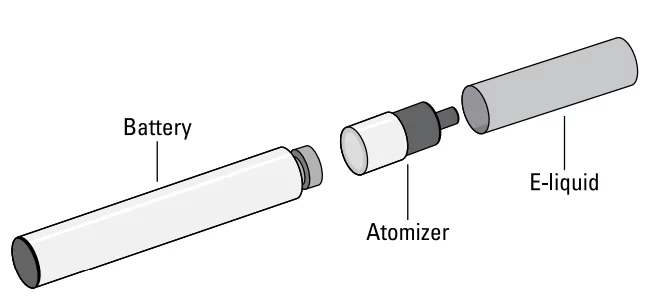
Batteries
Batteries for e-cigarettes come in three types:
- Disposable: Early devices such as the cig-a-likes (see the “Evolving Vaping Devices” section, later in this chapter) have limited lifespans and are meant to be thrown away when the device is used up. They are not rechargeable.
- Integrated batteries: These batteries are built into the device and are not meant to be replaced or removed. They have a finite number of rechargers after which the device needs to be disposed.
- Removable batteries: These batteries can be recharged. When they no longer recharge, they can be replaced. Removable and rechargeable batteries are typically found in more advanced devices.
Atomizers
The atomizer has a metal coil and a wick (usually made out of cotton). The battery heats the coil. E-juice is absorbed by the wick and heated. The heated e-liquid turns into vapor. There are three major kinds of atomizers:
- Disposable: These atomizers are the simplest type because they require no refilling or replacement. When the e-liquid is depleted, users throw away
the device. - Cartomizers: Cartomizers have joined the atomizer with a holder for the e-liquid. When the e-liquid begins to taste burned, it’s usually replaced, although some people clean and refill them.
- Clearomizers: A similar, but newer, design, clearomizers also contain the e-liquid and atomizer. E-liquid levels can be monitored because the material they’re made of is — you guessed it — clear.
E-liquids or e-juices
Simply put, an e-liquid or e-juice is the solution that is in a vape device for the purpose of vaping. These liquids vary considerably depending on the concentrations of each substance mixed into the juice. See the “Knowing What You’re Vaping” section, later in this chapter, for descriptions of the components of e-juice.
Vaping devices don’t actually emit vapor. Technically, they emit an aerosol. An aerosol contains particles and liquid suspended in air. Vapor refers to the gas form of a substance that’s normally a solid or a liquid. For example, water when it’s evaporated becomes water vapor. Smoke is composed of many particles and is considered an aerosol. Very important stuff to remember for your sixth-grade science test.
Evolving Vaping Devices
E-cigarettes are often described as having come to market in a wave of either three or four generations. There is not a bright line demarcating one generation from the next, but technological advances give you an idea of where the field has gone and where it’s headed. In general, over time, the devices have become more powerful, have more adjustable settings, and some now even track a user’s vaping behavior.
Image below provides illustrations of the four generations of vaping devices.
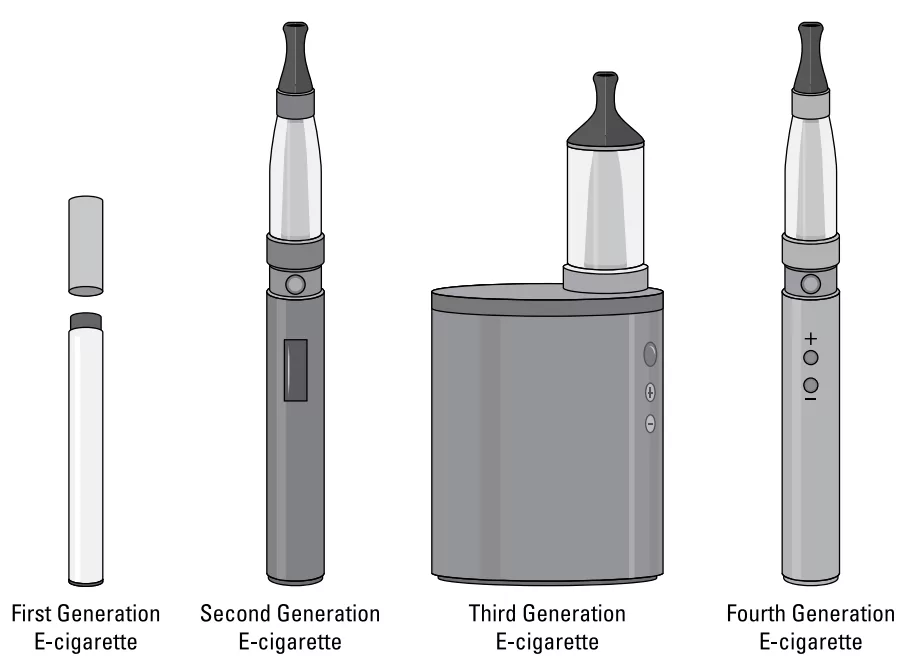
The first generation
The first generation of e-cigarettes were quite basic and consisted of a battery, an atomizer, and a cartridge of e-liquid. They’re often referred to as cig-a-likes. They generally look much like a regular, combustible cigarette. They’re also small and easy to conceal (see Chapter 7 for vaping info for parents). The experience of vaping with a cig-a-like is similar to smoking a regular cigarette and involves inhaling into the mouth first and then into the lungs.
Most of the first generation of e-cigarettes are not rechargeable or refillable. They’re fairly cheap and extremely easy to use. Gas stations and drugstores often carry them. They’re activated simply by inhaling, which turns the battery on and usually an LED lights up the end of the stick.
Later iterations of first-generation e-cigarettes include options for recharging the batteries and replacing the cartridges. Certain models have a button that you have to press in order to inhale. Some of these e-cigarettes come with a portable battery charger that is about the size of a package of regular cigarettes.
We talked informally to a number of vape shop customers who told us that they found first-generation e-cigarettes not very helpful when they were trying to quit regular smoking. They said these devices left them unsatisfied, still craving a regular cigarette. They claimed that later generations of e-cigarettes were considerably more helpful because later-generation devices delivered a higher amount of vape and nicotine. Obviously, these discussions can’t be considered a scientific study, but they’re interesting observations.
The second generation
The next generation of e-cigarettes is a bit more technologically advanced. They have more power and typically have on/off buttons. They usually look like pens or laser pointers.
Generally, batteries can be recharged and sometimes replaced. They have a cartridge called a clearomizer that’s refillable with e-liquid (see the “Atomizers” section, earlier in this chapter). Most second-generation devices have an important safety device in the form of a chip that turns off the device to prevent overheating.
The third generation
The third-generation vaping devices are also sometimes called advanced personal vaporizers. These devices come in lots of different styles and don’t look anything like traditional cigarettes. They tend to be much bigger than the older-generation products. They have more power and can heat the e-liquid to a higher temperature than older models, which may alter the toxicity profile of the vapor produced. Third-generation devices are rechargeable and refillable.
The power section of third-generation devices are called mods. Mods come in two major types:
- Mechanical: These devices don’t have a circuit board to control temperature or power. They’re simple devices, but they’re more dangerous than regulated mods because they run directly off the battery. The production of vapor declines over time as the battery discharges. Enthusiasts sometimes like to make their own devices, but that can lead to a bad outcome if someone doesn’t have advanced knowledge.
- Regulated: These devices have a chip that controls temperature and power; they include safety features such as automatic shutoff. Some of these devices allow the chip software to be updated. They don’t resemble combustible cigarettes or pens. There is usually a small screen that provides information about power.
WHAT DO OHMS HAVE TO DO WITH VAPING?
Talk to an avid vaper for a while and the discussion is likely to include electrical terms such as ohms, and sometimes the related terms voltage, amps, and watts. What in the world does this have to do with inhaling vapor from a device? It affects the individual experience of vaping and the desire for more or less vapor, flavoring, and heat.
Because our publisher wants us to make difficult subjects understandable to our readers, here goes. Instead of vaping, we’re going to talk about water. Imagine you’re really thirsty and all you had to drink with is a thin cocktail straw. It would be pretty hard to get enough water quickly to quench your thirst. So, how about a garden hose? Would that help? Sure, you could get more water more quickly. Okay, now consider a firehose turned on fully. Wow! Too much for you? Probably.
Now, let’s go back to vaping and talk about ohms. In vaping circles, most vapers focus on ohms and sub-ohm vaping. Ohms refer to the amount of resistance between two points in a conductor.
The conductor in a vaping device is called the coil. Coils that are thinner and longer create more resistance (think about a very long, thin straw) and, thus, transmit less electricity for heating the e-juice. Less heat results in less vapor produced. On the other hand, short, thick wires reduce resistance (more like a garden hose) and transmit more electricity and heat to produce a greater volume of vapor, flavors, and other possible additives such as nicotine. Many serious vapers prefer so-called sub-ohm devices that make lots of vapor (like a firehose allows lots of water flow). Sub-ohm refers to devices where the value of ohm is between 1.0 and 0.
Lower-resistance circuits allow for a greater range of power adjustments. Think about the firehose; it can be used with a full flow of water or a mere trickle. That gives vapers more options to adjust. But the converse is not true. High-resistance coils (like the thin straws) can’t handle a large flow without risking failure or bursting. Well-made, safe vaping devices have the equivalent of a circuit breaker to prevent damage or bursting.
The fourth generation
Technological advances continually find their way into each new generation of e-cigarettes. The newest e-cigarettes are even more powerful and have more bells and whistles than those that came before. There are more options, allowing even finer adjustments in temperature and power. Fourth-generation e-cigarettes also have airflow slots, which allow adjustments to the flow of the vapor.
These devices are usually used by experienced vapers, some of whom participate in competitions involving blowing smoke into various shapes and sizes.
For new advanced devices, the cable that comes with the device is for attaching a device to a computer to download updates. A computer’s USB port should not be used for recharging; instead, a standalone charger is preferable. If something goes wrong, you could lose not only a vaping device but a computer as well.
Pod systems
Pod systems are the newest wave of vaping devices. Pods are somewhat unique vaping devices and are not easily categorized. Some pods look strikingly like
computer USB flash drives; others look like pens or cosmetic products. There’s no assembly, and there are no adjustable buttons or switches. However, some devices have a single power button, whereas others are activated solely by taking a drag. Pods are easily recharged with the USB charger they come with. Check the image below for an idea of what some of these systems look like.
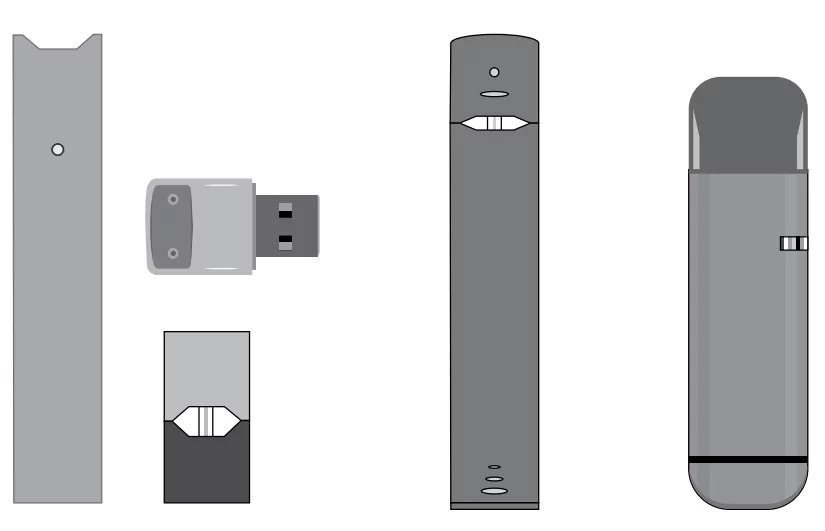
The devices were designed to be low hassle and easy to operate. They’re small and discrete, lightweight, easy to carry, and produce a minimal cloud of vapor. Pod designers are trying to mimic the experience of smoking combustible cigarettes as closely as possible to make the transition away from regular cigarettes easier. The nicotine in a pod system is absorbed quickly, like that of a combustible cigarette.
Juul, one of the first pod system devices, was designed by a startup company which created several e-cigarettes prior to their Juul product. The founders, Adam Bowen and James Monsees, were former smokers and they ostensibly hoped to target the one billion smokers worldwide, most of whom want to quit. The Juul was launched in 2015 and in a few years, the product captured a substantial majority of the e-cigarette market.
Knowing What You’re Vaping
All vaping devices contain a liquid, which turns into aerosol (often referred to as vapor) when heated. It’s important that consumers purchase their e-liquids from reputable sources because accuracy of ingredients listed on labels has been a problem. This problem should resolve in the near future; the U.S. Food and Drug Administration (FDA) is in the process of implementing more regulatory authority for e-cigarettes and their contents.
As a small beginning, ingredients should be listed on the label. Almost all e-liquids contain some combination of the following:
- Vegetable glycerin: Vegetable glycerin is derived from plant oils. It’s used in cosmetics, food, many pharmaceuticals, and toothpaste. Vegetable glycerin is colorless, has a slight sweet taste, and has the consistency of syrup. Using increased percentages of vegetable glycerin in vape juice promotes more cloud, which appeals to some users. Vegetable glycerin makes vaping smoother and easier on the throat.
- Propylene glycol: Propylene glycol is a synthetic substance also used in cosmetics, food, and pharmaceuticals. It’s odorless and also slightly sweet. Propylene glycol is somewhat thinner than vegetable glycerin, but slightly thicker than water. Propylene glycol in e-liquid enhances flavor and creates more of what users describe as a desired “throat hit.”
Depending on individual tastes for flavor, throat hit, and amount of vapor, different proportions of vegetable glycerin and propylene glycol can be mixed for e-liquids.
Nicotine
When people quit smoking, they crave nicotine. They want a replacement for nicotine from smoking and in as similar a form as possible to their old smoking habits. Therefore, many e-liquids provide a jolt of nicotine.
Nicotine gets a bad rap among much of the public. That’s because it’s so closely associated with the harm caused by smoking combustible cigarettes. However, as we’ve said more than once elsewhere, it’s the inhalation of burning tobacco and its resulting tar that causes most of the problems from smoking. Nicotine is vastly less harmful, although it is highly addictive.
Most, but not all, e-liquids contain nicotine. Some contain only flavors. Nicotine concentrations vary widely among different e-liquid products. We’ve seen a range from 0 to 50 milligrams of nicotine per milliliter. Most smokers wanting to use vaping in order to quit cigarettes need to experiment with different concentrations of nicotine to find what works best to control cravings.
Nicotine salt (a form of natural nicotine) is sometimes combined with benzoic acid for vaping purposes. Nicotine salt absorbs more quickly into the bloodstream than so-called freebase nicotine found in most e-juice. It has a smoother hit, allowing users to increase the nicotine concentration they’re consuming.
Nicotine salt requires its own type of vaping device such as the Juul or some type of other pod system or fourth-generation vaping device. Juul claims that its device using nicotine salt is absorbed 2.7 times faster than regular nicotine in other e-cigarettes (and similar to that of regular cigarettes). That absorption rate may cause Juul users to become addicted more quickly than those who use other vaping products. Anecdotal evidence supports this increased risk of addiction, although scientific research needs to confirm (or refute) this possibility.
Flavoring
One of the most seductive parts of vaping rituals is the variety of available flavors. Manufacturers are competing with regular tobacco companies and realize they can enhance the desirability of their product by infusing it with a variety of tantalizing flavors. Unfortunately, some of these flavors have been particularly tantalizing to teens.
Some flavors are derived from food extracts. Others are labeled simply as “natural and artificial flavorings.” Natural refers to flavors derived from plants or animals. Artificial can refer to almost anything, and manufacturers rarely disclose specifics. There’s no way to know exactly what’s in those flavorings.
Currently, there are literally thousands of vape flavors available — everything from banana nut bread to bacon to menthol. Flavors like gummy bears or bubble gum have great appeal to teens and young adults; for that reason, many people have called for banning flavors from e-cigarettes. Under this pressure, Juul has recently stopped selling vape cartridges containing any flavors other than tobacco or menthol. The U.S. federal government is actively considering whether to ban most vape flavors for other manufacturers as well.
Vaping CBD or THC
Cannabidiol (CBD) is an active component found in the cannabis plant. Tetrahydrocannabinol (THC) is the active constituent in cannabis that gives people a sense of euphoria or what’s called a high. Both come as an oil that can be vaped when mixed with vegetable glycerin and propylene glycol.
You may wonder what the difference is between cannabis, hemp, and marijuana. Hemp and marijuana are both cannabis plants. To be called hemp, it must contain less than 0.3 percent THC. Marijuana contains more than 0.3 percent THC. Sometimes the two plants crosspollinate and a hemp crop turns into a marijuana crop. Both CBD and THC are, thus, isolated components of two different types of cannabis plant.
Vaping CBD
CBD burst onto the scene quite recently. The 2018 Farm Bill changed everything. It legalized the production and sale of hemp that contains less than 0.3 percent THC. Today, you can find CBD derived from the hemp plant in everything from lotions to lollipops, water, tea, soft drinks, candy, and vape pens and other devices. You can buy these CBD products at your local drugstore, grocery store, CBD specialty store, smoke shop, vape store, online, and more.
You may wonder what made CBD so ubiquitous given that it doesn’t make you high. CBD has numerous purported health benefits. Although the FDA has only approved CBD for the treatment of difficult-to-control epilepsy, claims of its efficacy for other problems abound. A partial list of these positive health assertions includes the treatment and/or amelioration of:
- Alzheimer’s
- Anxiety
- Arthritis
- Brain injury
- Cancer
- Chronic pain
- Depression
- Inflammation
- Inflammatory bowel disease (IBD)
- Insomnia
- Migraines
- Nausea
- Parkinson’s disease
- Post-traumatic stress disorder (PTSD)
- Psychosis onset
- Skin conditions
The value of CBD is recommended for more than humans. You can often buy it at your local veterinarian’s office for your dog or cat. It’s promoted for animals with arthritis, pain, seizures, separation anxiety, and more.
If the majority of these purported benefits prove to be valid, most of us will be able to empty our medicine cabinets and fill them with CBD products. Unlikely.
Vaping THC
California was the first state to legalize medical marijuana, in 1996, followed by over 30 states in the following two decades or so. Colorado and Washington led the way for legalization and/or decriminalization of recreational marijuana and THC in 2012, followed by another ten states and counting.
The major advantage of vaping THC over smoking marijuana is that vaping doesn’t involve burning, which by itself produces a variety of additional chemicals of unknown risks. However, whether vaping THC is safer than smoking marijuana is an open question. One serious concern about vaping THC is that it has been implicated as a possible cause of some cases of serious lung damage, possibly due to ingredients mixed with it.
Health benefits of medical marijuana have been difficult to firmly establish because federal law made such studies exceptionally difficult to conduct for decades. However, there is substantial evidence that marijuana:
- Helps with chronic pain
- Works well to decrease chemotherapy-induced nausea
- Helps decrease spasticity for people with multiple sclerosis (MS)
There is moderate evidence that marijuana improves the sleep of people with:
- Chronic pain
- Fibromyalgia
- MS
- Sleep apnea
There is some (limited) evidence that marijuana helps
- Decrease anxiety
- Increase appetite
- Decrease intraocular pressure associated with glaucoma
- Improve symptoms of PTSD
- Improve a few behavioral symptoms of dementia such as agitation and aggression
Finally, there is very preliminary evidence that marijuana may help people decrease or abstain from abusing alcohol or opioids and perhaps tobacco. Additional, preliminary evidence has provided hints that THC and possibly CBD may have a beneficial neuroprotective effect following traumatic brain injury. Considerably more research is needed to confirm or refute these exciting possibilities.
Even in states where marijuana is legal, a robust black market offers THC for vaping, the safety of which is unknown. And vaping THC has been associated with serious cases of vaping-related lung damage (see Chapter 6). Never buy any vaping products from the street.

